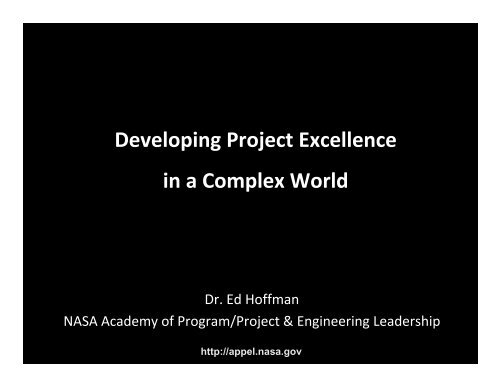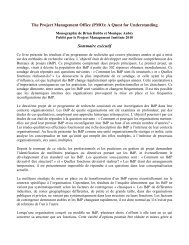Developing Project Excellence in a Complex World
Developing Project Excellence in a Complex World
Developing Project Excellence in a Complex World
You also want an ePaper? Increase the reach of your titles
YUMPU automatically turns print PDFs into web optimized ePapers that Google loves.
<strong>Develop<strong>in</strong>g</strong> <strong>Project</strong> <strong>Excellence</strong><br />
<strong>in</strong> a <strong>Complex</strong> <strong>World</strong><br />
Dr. Ed Hoffman<br />
NASA Academy of Program/<strong>Project</strong> & Eng<strong>in</strong>eer<strong>in</strong>g Leadership<br />
http://appel.nasa.gov
Explor<strong>in</strong>g Saturn and Its Moons Close Up<br />
Image from Voyager 2 (1981)<br />
http://appel.nasa.gov
Cass<strong>in</strong>i‐Huygens<br />
‣ U.S. ‐ European mission to explore Saturn<br />
‣ NASA and Italian Space Agency: Cass<strong>in</strong>i spacecraft<br />
‣ European Space Agency: Huygens probe<br />
‣ Launched October 1997<br />
‣ 6.7 year voyage to Saturn<br />
‣ $3.27 billion total cost to date<br />
http://appel.nasa.gov
Cass<strong>in</strong>i and Huygens<br />
Cass<strong>in</strong>i<br />
• Delivered Huygens probe<br />
to Titan<br />
• Rema<strong>in</strong>ed <strong>in</strong> orbit around<br />
Saturn for detailed studies<br />
of the planet, its r<strong>in</strong>gs and<br />
satellites (moons)<br />
Huygens<br />
• Released by Cass<strong>in</strong>i to land<br />
on surface of Saturn’s moon<br />
Titan<br />
• Investigated characteristics<br />
of Titan’s atmosphere and<br />
surface<br />
Cass<strong>in</strong>i<br />
Huygens<br />
Saturn<br />
Titan<br />
http://appel.nasa.gov
Cass<strong>in</strong>i‐Huygens: the <strong>Complex</strong> <strong>Project</strong> Environment<br />
<strong>Complex</strong> <strong>Project</strong>-Based<br />
Functional<br />
Organization<br />
Organization<br />
Problems Novel Rout<strong>in</strong>e<br />
Technology New/<strong>in</strong>vented Improved/more efficient<br />
Team Global, multidiscipl<strong>in</strong>ary Local, homogeneous<br />
Cost Life cycle Unit<br />
Schedule <strong>Project</strong> completion Productivity rate<br />
Customer Involved at <strong>in</strong>ception Involved at po<strong>in</strong>t of sale<br />
Survival skill Adaptation Control/stability<br />
http://appel.nasa.gov
Technical <strong>Complex</strong>ity: Zero Room for Error<br />
‣ Journey to Saturn <strong>in</strong>cluded<br />
“gravity assists” (sl<strong>in</strong>gshot<br />
acceleration effects) from<br />
Venus, Earth and Jupiter -<br />
<strong>in</strong>credibly precise tim<strong>in</strong>g<br />
‣ Cass<strong>in</strong>i orbiter would “<strong>in</strong>sert”<br />
Huygens probe <strong>in</strong> orbit of<br />
Titan (one of Saturn’s<br />
moons)<br />
Cass<strong>in</strong>i trajectory to Saturn<br />
‣ <strong>Complex</strong> communications<br />
among Cass<strong>in</strong>i, Huygens,<br />
Deep Space Network, and<br />
ground system<br />
http://appel.nasa.gov<br />
Huygens descent to surface of Titan
Organizational and Strategic <strong>Complex</strong>ity<br />
Italian Space Agency<br />
NASA<br />
ESA<br />
Cass<strong>in</strong>i high-ga<strong>in</strong><br />
antenna; radio<br />
subsystem<br />
equipment<br />
Cass<strong>in</strong>i orbiter;<br />
launch vehicle<br />
and associated<br />
<strong>in</strong>tegration & test<br />
Huygens probe<br />
and associated<br />
communications<br />
equipment on<br />
Cass<strong>in</strong>i orbiter<br />
International partnerships affect<br />
organizational and strategic complexity<br />
http://appel.nasa.gov
Organizational <strong>Complex</strong>ity: The Science Mission<br />
• 260 scientists<br />
• 17 countries<br />
• 10 time zones<br />
• 18 scientific <strong>in</strong>struments (payloads)<br />
with Pr<strong>in</strong>cipal Investigators<br />
http://appel.nasa.gov
<strong>Project</strong> Management Challenge<br />
All 18 payloads had reserves<br />
• Cost ($ per fiscal year)<br />
• Mass (kg)<br />
• Power (watts)<br />
• Data rate to the spacecraft bus (kilobytes/second)<br />
Overruns would lead to de‐scop<strong>in</strong>g (i.e., <strong>in</strong>struments cut)<br />
Problem:<br />
How would you manage the reserves to <strong>in</strong>crease the<br />
likelihood that all <strong>in</strong>struments would fly on the spacecraft?<br />
http://appel.nasa.gov
<strong>Project</strong> Management Challenge Resolved<br />
Solution:<br />
Electronic trad<strong>in</strong>g exchange for Pr<strong>in</strong>cipal Investigators to<br />
trade reserves <strong>in</strong> cost, mass, power, and data rate.<br />
• Governed by project management team (<strong>in</strong>cl. veto<br />
power)<br />
• Created w<strong>in</strong>‐w<strong>in</strong> <strong>in</strong>centive for all<br />
• Gave PIs ownership / assured buy‐<strong>in</strong><br />
http://appel.nasa.gov
A New Way of Th<strong>in</strong>k<strong>in</strong>g and Learn<strong>in</strong>g<br />
To cope with a challeng<strong>in</strong>g world,<br />
any entity must develop the capacity of<br />
shift<strong>in</strong>g and chang<strong>in</strong>g—<br />
of develop<strong>in</strong>g new skills and attitudes;<br />
<strong>in</strong> short the capacity of learn<strong>in</strong>g.<br />
Arie De Geus, The Liv<strong>in</strong>g Company<br />
http://appel.nasa.gov
Qualities of an Adaptive Organization<br />
1. Elephants <strong>in</strong> the room are named.<br />
2. Responsibility for the future is shared.<br />
3. Independent judgment is expected.<br />
4. Leadership capacity is developed.<br />
5. Reflection and cont<strong>in</strong>uous learn<strong>in</strong>g are<br />
<strong>in</strong>stitutionalized.<br />
Source: Grashow, Heifetz, & L<strong>in</strong>sky, The Practice of Adaptive Leadership<br />
http://appel.nasa.gov
<strong>Project</strong>‐Based Environment<br />
Strengths<br />
• Adaptable to chang<strong>in</strong>g<br />
circumstances<br />
Weaknesses<br />
• Diffuse authority /<br />
lack of direct control<br />
• Customer orientation<br />
• Tunnel vision<br />
• Focus on product, not<br />
organization<br />
• Multidiscipl<strong>in</strong>ary teams<br />
• Organizational cohesion<br />
‣ Decentralized<br />
learn<strong>in</strong>g<br />
‣ Knowledge shar<strong>in</strong>g<br />
across community<br />
http://appel.nasa.gov
Why a <strong>Project</strong> Academy at NASA?<br />
To help transform NASA’s project‐based environment <strong>in</strong>to a learn<strong>in</strong>g organization<br />
Columbia<br />
accident<br />
Mars<br />
failures<br />
2003<br />
1999<br />
Challenger<br />
accident<br />
1986<br />
“NASA's current organization…<br />
has not demonstrated the characteristics of a<br />
learn<strong>in</strong>g organization.”<br />
Columbia Accident Investigation Board Report<br />
http://appel.nasa.gov
Meet<strong>in</strong>g Multiple Needs<br />
INDIVIDUAL<br />
COMPETENCIES<br />
TEAM<br />
PROJECT SUCCESS<br />
ORGANIZATION<br />
SUSTAINABILITY<br />
http://appel.nasa.gov
Integrated Competency Model<br />
http://appel.nasa.gov
<strong>Project</strong> Academy Roles and Responsibilities<br />
‣ <strong>Project</strong> workforce development<br />
‣ Advocacy for the learn<strong>in</strong>g requirements of practitioners<br />
‣ Def<strong>in</strong><strong>in</strong>g key concepts and vocabulary for the project<br />
community<br />
‣ Alignment with corporate strategy<br />
‣ Alignment with external stakeholders<br />
‣ Promotion of communities of lifelong learn<strong>in</strong>g<br />
‣ Promotion of susta<strong>in</strong>able organizational capability<br />
http://appel.nasa.gov
Key Assumptions and Biases<br />
‣ Practitioners know best.<br />
‣ 85‐90% of learn<strong>in</strong>g takes place on the job.<br />
‣ Learn<strong>in</strong>g is contextual — different career stages have<br />
different requirements.<br />
‣ Optimal performance and learn<strong>in</strong>g come together at the<br />
team level.<br />
http://appel.nasa.gov
Align and Focus<br />
Align with organizational strategy,<br />
focus on practitioners.<br />
Mission<br />
requirements<br />
Competency<br />
model<br />
Career<br />
development<br />
framework<br />
Tra<strong>in</strong><strong>in</strong>g curriculum<br />
for all career levels<br />
Hands‐on<br />
assignments<br />
Coach<strong>in</strong>g and<br />
mentor<strong>in</strong>g<br />
Expert practitioner<br />
support to teams<br />
Knowledge<br />
shar<strong>in</strong>g<br />
forums &<br />
publications<br />
http://appel.nasa.gov
Individual, Team, Organization<br />
INDIVIDUAL<br />
TEAM<br />
ORGANIZATION<br />
APPROACH<br />
• Tra<strong>in</strong><strong>in</strong>g curriculum<br />
Direct support to<br />
Knowledge shar<strong>in</strong>g<br />
• Development programs<br />
project teams<br />
ACTIVITIES<br />
•core<br />
• onl<strong>in</strong>e<br />
•forums<br />
curriculum<br />
assessments<br />
• publications<br />
•<strong>in</strong>‐depth<br />
•workshops<br />
•case studies<br />
offer<strong>in</strong>gs<br />
•mentor<strong>in</strong>g /<br />
• multimedia<br />
• hands‐on<br />
coach<strong>in</strong>g<br />
• communities of practice<br />
opportunities<br />
•expert practitioners<br />
•team build<strong>in</strong>g<br />
• technical support<br />
http://appel.nasa.gov
Individual<br />
‣ Tra<strong>in</strong><strong>in</strong>g curriculum<br />
- Core for 4 career levels<br />
- In‐depth offer<strong>in</strong>gs<br />
‣ Hands‐on opportunities and<br />
developmental assignments<br />
PMI Registered Provider of Professional Development Units<br />
http://appel.nasa.gov
Direct support to project teams<br />
Team<br />
‣ Onl<strong>in</strong>e assessments<br />
‣ Workshops<br />
‣ Mentor<strong>in</strong>g and coach<strong>in</strong>g<br />
‣ Expert practitioners and technical<br />
lifecycle support<br />
‣ Team build<strong>in</strong>g and process<br />
support<br />
http://appel.nasa.gov
Organization<br />
Knowledge shar<strong>in</strong>g<br />
‣ Forums for project managers,<br />
systems eng<strong>in</strong>eers, and<br />
pr<strong>in</strong>cipal <strong>in</strong>vestigators<br />
‣ Publications<br />
‣ Case studies<br />
‣ Multimedia<br />
‣ Communities of practice<br />
http://appel.nasa.gov
<strong>Develop<strong>in</strong>g</strong> <strong>Project</strong> <strong>Excellence</strong><br />
In a world of complex projects, adaptability is critical.<br />
<strong>Project</strong> excellence depends on capability at the<br />
<strong>in</strong>dividual, team, and organizational levels.<br />
A project academy can serve a focal po<strong>in</strong>t for learn<strong>in</strong>g<br />
and align<strong>in</strong>g projects with strategic goals.<br />
http://appel.nasa.gov












